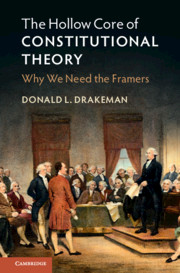Book contents
- The Hollow Core of Constitutional Theory
- The Hollow Core of Constitutional Theory
- Copyright page
- Contents
- Preface
- 1 The Framers and Contemporary Constitutional Theory
- 2 The Framers’ Intentions
- 3 Original Methods and the Limits of Interpretation
- 4 Original Methods Updating
- 5 The Semantic Summing Problem
- 6 Is Corpus Linguistics Better than Flipping a Coin?
- 7 The Framers’ Intentions Can Solve the Semantic Summing Problem
- 8 Interpretation and Sociological Legitimacy
- 9 Noninterpretive Decisions
- 10 Conclusion
- Bibliography
- Index
4 - Original Methods Updating
Published online by Cambridge University Press: 26 January 2021
- The Hollow Core of Constitutional Theory
- The Hollow Core of Constitutional Theory
- Copyright page
- Contents
- Preface
- 1 The Framers and Contemporary Constitutional Theory
- 2 The Framers’ Intentions
- 3 Original Methods and the Limits of Interpretation
- 4 Original Methods Updating
- 5 The Semantic Summing Problem
- 6 Is Corpus Linguistics Better than Flipping a Coin?
- 7 The Framers’ Intentions Can Solve the Semantic Summing Problem
- 8 Interpretation and Sociological Legitimacy
- 9 Noninterpretive Decisions
- 10 Conclusion
- Bibliography
- Index
Summary
The jurisprudential tradition that created the original methods that were in effect at the time of the Constitution provides the foundation for an interpretive approach for applying the Constitution’s fixed text to changing circumstances. Across the centuries, even commentators with strong preferences for following the lawmaker’s original meaning have recognized that there are legitimate times for judges to adapt an old law to fit new circumstances. In light of that history, this chapter describes a principled approach to adapting laws to changing circumstances that has its foundation in Edward Coke and William Blackstone, and was developed over the centuries in the UK courts.
Keywords
- Type
- Chapter
- Information
- The Hollow Core of Constitutional TheoryWhy We Need the Framers, pp. 78 - 96Publisher: Cambridge University PressPrint publication year: 2021

